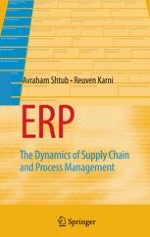2010 | Buch
Über dieses Buch
ERP: The Dynamics of Supply Chain and Process Management is a complete updating and expansion of Avraham Shtub’s award-winning 1999 text Enterprise Resource Planning (ERP): The Dynamics of Operations Management. New chapters, written together with his co-author Reuven Karni, cover enterprise process modeling; design of business processes; a complete revision of the original chapter on the integrated order-fulfillment process using ERP; business process management; business process improvement; and a new appendix on simulating process life cycles: using serious games as teaching aids.
MERPTM is designed to facilitate the teaching of integrated operations of a business organization with a focus on corporate performance management. It reflects a fully live environment and allows students to participate in a virtual organization made real and dynamic as minute-by-minute business events and conditions unfold.
This book is ideal for use in academic and executive programs aimed at teaching students how integrated systems work. It is suitable as a textbook for the basic MBA Operations Management course or as a text for courses on ERP systems and the development of business processes. In an industrial engineering program it could serve to give students their first, and perhaps only, introduction to business issues like market demand and supplier relationships.
"I used Avy Shtub’s award-winning 1999 book on ERP and the accompanying Operations Trainer software in several leading MBA programs in the United States and Europe. Most of the courses were delivered in traditional classroom settings but some of them were offered fully online. The current revision and second edition of the book, co-written with Reuven Karni, adds new materials with an emphasis on services and business processes, provides excellent, detailed examples, and revises old ones of the previous edition. The book is nicely complemented and enhanced by theaddition of a unique, dynamic, online simulation package MERP™ that represents a major upgrade to the old, PC-based Operations Trainer. In my reading, the book’s first main theme, Integrated Production and Order Management (IPOM), is a different, and perhaps more valid, take on the many issues associated with Supply Chain Management. The authors touch on all facets and issues of Operations and Supply Chain Management and provide a theory-based and sound, practice-proven approach to the problems present in any organization. The second main theme covers the design and improvement of enterprise and business processes, touching on facets and issues relating to process-based enterprise management. I would highly recommend the book and the accompanying software to any instructor teaching Operations/Supply Chain Management, Business Process Management or Industrial Engineering."
-- Gyula Vastag (Corvinus University of Budapest, Hungary)
Anzeige
